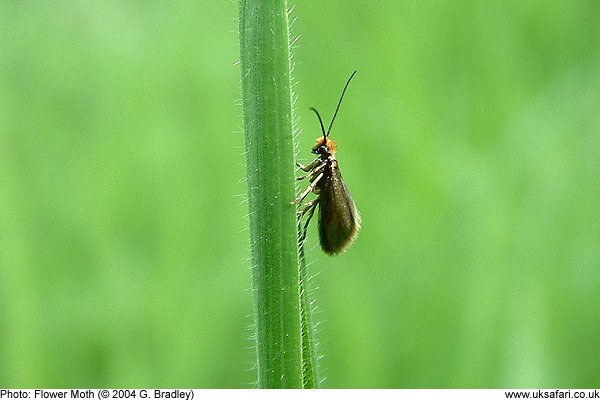 Flower Moths
Flower Moths
News > Flower Moths >

It may look fairly ordinary, but this little insect is a living fossil. It's the moth that time forgot. It's quite literally a dinosaur among Lepidoptera and it goes by the scientific name of Micropterix calthella.
Once upon a time, many, many years ago, the ancestors of todays butterflies and moths had mandibles for chewing their food instead of those natty looking curly tongues we see on most of them today. Somewhere along the evolutionary track (about 160 million years ago), when the curly tongues (known as a proboscis) became the trendy thing for moths and butterflies to have, this little guy decided it was one body modification too far.
You see as well as that rather fetching 1980's-Tina-Turner-esque hairdo, this little moth is still equipped with old-fashioned mandibles (jaws) for chewing his food. It's a chewer rather than a sucker.
For some reason Micropterix decided not to go along with the curly tongue evolution, and yet the species is still with us, and is surviving very well. It makes you wonder why the other moths felt the need to change. Perhaps there wasn't enough pollen to go around, or maybe the competition for pollen was too great.
Flower Moths can be found throughout the UK, and at this time of year you'll often find them perched on a buttercup nibbling away at pollen grains.
More info at: Flower Moths Fact File

 Popular Pages
Popular Pages
Amphibians, Bats, Badgers, Beetles, Birds, Birds of Prey, Bumble Bees, Butterflies, Caterpillars, Creepy-Crawlies, Deadly Spiders, Dolphins, Dragonflies, E-Postcards, False Widow Spiders, Free Newsletter, Frogs, Fungi, Garden Spiders, Glow-Worms, Grey Squirrels, Hedgehogs, House Spiders, Ladybirds, Mammals, Marine Mammals, Moths, Owls, Reptiles, Spiders, Toads, Trees, Wildlife Hospitals
© Copyright 2017 G. Bradley - UK Safari | About Us | Links | Contributors



 Related Pages
Related Pages
